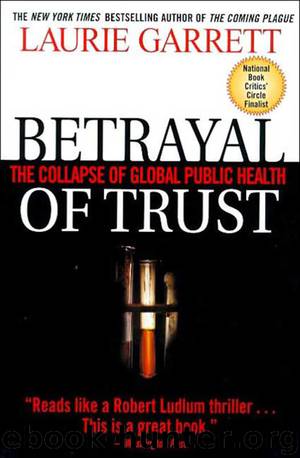Betrayal of Trust by Laurie Garrett

Author:Laurie Garrett [Garrett, Laurie]
Language: eng
Format: epub
Publisher: Hyperion Digital
Published: 2000-09-22T04:00:00+00:00
Public health solutions to drug problems—however exaggerated those problems may have been—were completely ignored. The public’s perception, contrary to all evidence, was that crime was increasing; and in the collective mind’s eye the perpetrators all wore the face of a black crack head. That perception was catered to. Bush named arch-conservative William Bennett his Drug Czar. Bennett believed that crack was so addictive, and produced such violent behavior in users, that the only hope for stemming a tidal wave of drug-induced horror was mass arrests.
Ninety percent of all incarcerations for drug offenses made at the state and federal level during the Bush administration (1989 to 1992) were of African-Americans or Latinos.502 African-American men, in particular, were targeted by law enforcement: though they comprised only 7 percent of the U.S. population in 1992, they made up half the population of prisoners.503 Police forces clearly targeted ghettos and slum areas for drug enforcement.504 There were no DEA raids with heavy police artillery waged against colleges, Silicon Valley, hangouts for high fashion models, private white clubs in Manhattan, or the latest chic club for movie stars in Malibu, though drug use was a prominent feature in all those settings.
“An extremely disturbing current in public policy debates of the past decade is the tendency to identify the causes of problems confronting minority communities as the failings and inadequacies of black people themselves,” the Drug Policy Foundation observed.505 “From the policy analyst’s point of view, the root of black communities’ poverty and hopelessness seemed to be nested in a pathological set of self-defeating and destructive behaviors, a group pathology unprecedented in its persistence and incidence among black people.
“Were the adherents to this view racists and bigots? Were those who shared this vision all right-wing conservatives? No. Respected scholars at major research universities embraced this perspective. The mainstream black press … embraced readily the self-help rhetoric. And black churches, particularly the more fundamentalist in orientation that bloomed in the 1980s, unhesitatingly adopted this stance.”
It was, critics charged, another blame-the-victim perspective: if African-Americans were arrested and imprisoned more frequently for drug-related crimes, it must signal an inner, collective weakness in character, genes, community structures, or families. The Bush administration’s ultimate target was not, in fact, the drugs: it was deteriorating moral and family values that were said to be the root cause of drug abuse.506
Drug-related violence, however, was the result of turf battles between drug dealers and gangs. Little—in some communities, no—crack violence was deliberately directed at the general citizenry.507 The majority of all cocaine users during the Reagan and Bush years were white; but arrests were overwhelmingly black. And by 1993 four million Americans, most of them African-American, would have lost their right to vote due to criminal drug convictions.508
To justify the criminal sweeps and even calls for shooting or beheading crack users,509 politicians and law enforcement officials cited scientific papers regarding the physiological effects of crack and cocaine.
“Crack is definitely a unique compound, compared to regular cocaine,” said psychiatrist Scott Lukas of Harvard School of Medicine.
Download
This site does not store any files on its server. We only index and link to content provided by other sites. Please contact the content providers to delete copyright contents if any and email us, we'll remove relevant links or contents immediately.
| Anthropology | Archaeology |
| Philosophy | Politics & Government |
| Social Sciences | Sociology |
| Women's Studies |
The Secret History by Donna Tartt(18846)
The Social Justice Warrior Handbook by Lisa De Pasquale(12141)
Thirteen Reasons Why by Jay Asher(8796)
This Is How You Lose Her by Junot Diaz(6794)
Weapons of Math Destruction by Cathy O'Neil(6146)
Zero to One by Peter Thiel(5686)
Beartown by Fredrik Backman(5599)
The Myth of the Strong Leader by Archie Brown(5425)
The Fire Next Time by James Baldwin(5249)
How Democracies Die by Steven Levitsky & Daniel Ziblatt(5128)
Promise Me, Dad by Joe Biden(5087)
Stone's Rules by Roger Stone(5026)
A Higher Loyalty: Truth, Lies, and Leadership by James Comey(4845)
100 Deadly Skills by Clint Emerson(4840)
Rise and Kill First by Ronen Bergman(4704)
Secrecy World by Jake Bernstein(4646)
The David Icke Guide to the Global Conspiracy (and how to end it) by David Icke(4625)
The Farm by Tom Rob Smith(4437)
The Doomsday Machine by Daniel Ellsberg(4416)
